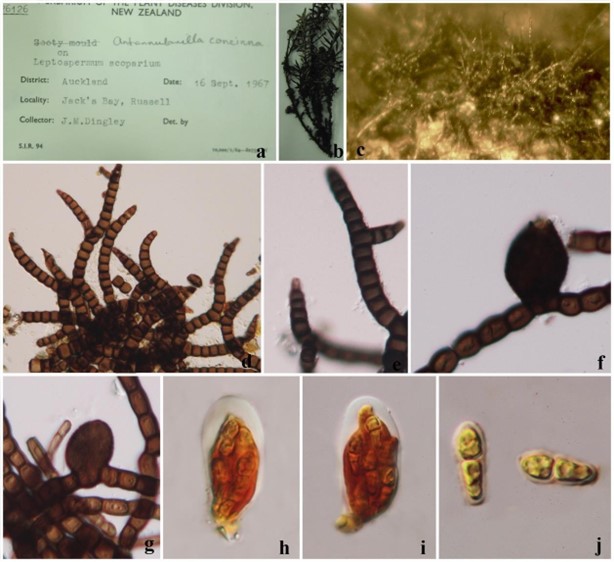Antennulariella concinna (L.R. Fraser) S. Hughes, Mycologia 68(4): 719 (1976). Fig. 5
≡ Limacinia concinna L.R. Fraser, Proc. Linn. Soc. N.S.W. 60(3-4): 171 (1935).
MycoBank number: MB 308726; Index Fungorum number: IF 308726; Facesoffungi number: FoF 06952;
Mycelium superficial, cylindrical or “tube”-like, brown to dark brown, septate, smooth- walled, with constricted at and dark each septum, narrow at end cell. Sexual morph: Ascomata subglobose, developing on mycelium, with ostioles at maturity, smooth or roughened walls, dark brown to black. Hamathecium not observed in this study. Asci 8-spored, bitunicate, ellipsoid to cylindrical, with short pedicel. Ascospores overlapping, 1–3-seriate, clavate, 1-septate, 2-layered, slightly constricted at septum, upper cell shorter and wider lower cell, hyaline, smooth-walled to verrucose. Asexual morph: Undetermined.
Material examined – New Zealand, Auckland, Jack’s Bay, Russell, on Leptospermum scoparium, 16 September 1967, J.M. Dingley (PDD 26126, non-type).
Notes – The holotype specimen of Antennulariella fuliginosa was illustrated in Hyde et al. (2013), however figures of asci and ascospores were presented as drawings. Here, we illustrate asci and ascospores of Antennulariella species using a specimen of A. concinna from PDD, however measurements are unavailable (Fig. 5).

Figure 5 – Antennulariella concinna (PDD 26126). a–b Specimen and descriptions. c Ascomata on substrate. d–e Septate mycelium. f–g Ascomata. h–i Ascus stained in Melzer’s reagent. j Ascospores stained in Melzer’s reagent.
